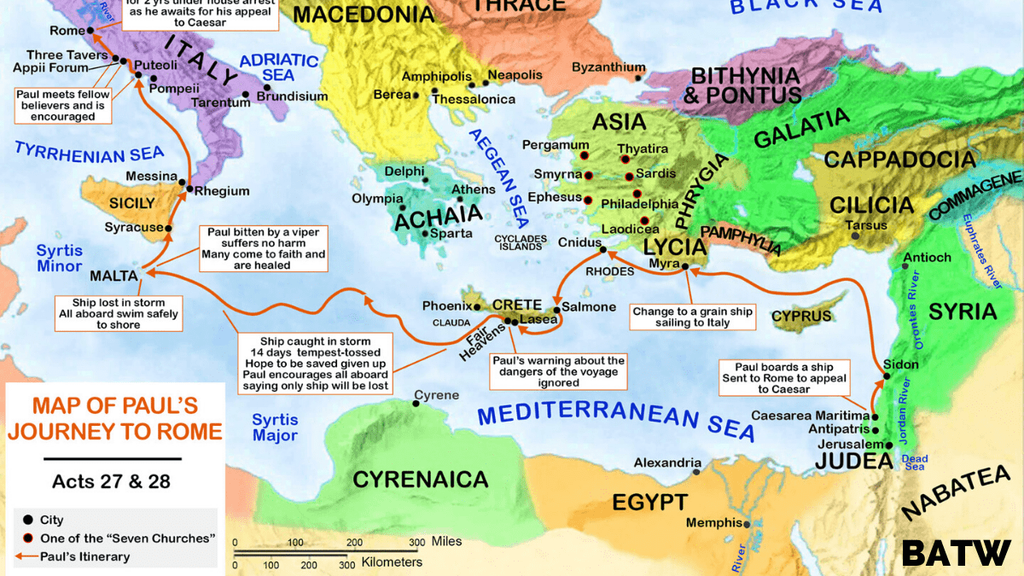Paul’s Journey from Jerusalem to Rome
Table of Contents

Figure 1: Paul’s Journey to Rome
Paul’s Journey to and Sojourn in Rome
The Apostle Paul’s journey from Jerusalem to Rome marks a significant moment in the spread of early Christianity. As one of the key figures in the New Testament, Paul’s ministry took him across the Roman Empire, culminating in his fateful journey to Rome, where he spent his final years under house arrest. This essay will trace the main events that led to his journey, his shipwreck on Malta, and his eventual imprisonment in Rome, focusing on the historical and theological significance of these events.
The last phase of Paul’s time in Jerusalem is fraught with tension. After returning from his missionary journeys, he was arrested in the city due to accusations from Jewish leaders who viewed him as a threat because of his preaching to Gentiles and supposedly violating Jewish laws (Acts 21:27-36). Fearing for his life, Roman authorities placed him under protective custody. Paul, being a Roman citizen, appealed to Caesar, a legal right that ultimately led to his journey to Rome (Acts 25:11-12). It is important to note that Paul’s appeal to Caesar wasn’t merely a legal move—it carried theological weight as well. He believed he was destined to preach the gospel in Rome, the heart of the Empire, fulfilling his mission to bring the Christian message to the “ends of the earth” (Acts 23:11).
Paul’s journey to Rome was far from straightforward. On the way, Paul experienced a dramatic shipwreck on the island of Malta (Acts 27:39-44). While en route by sea, the ship encountered a violent storm that drove it off course. Despite being a prisoner, Paul reassured the crew and passengers, and all aboard survived the wreck. This event not only underscores Paul’s leadership but also his faith in God’s promise that he would reach Rome.
Once in Rome, Paul’s situation becomes somewhat unique for a prisoner. As Acts 28:30-31 recounts, he lived under house arrest for two years in a rented home, where he continued to preach the gospel and receive visitors freely. Though technically still a prisoner, his confinement allowed him to maintain an active role in the spread of Christianity. While under arrest, Paul is believed to have written several of his Prison Epistles, including Ephesians, Philippians, Colossians, and Philemon. In these letters, Paul frequently mentions his chains, providing insight into his physical circumstances while emphasizing the spiritual freedom he experienced through his faith.
The evidence suggesting that Paul wrote these letters from Rome comes from both internal references within the letters themselves and from the broader historical and geographical context. For instance, in Philippians 1:13, Paul mentions that the gospel had become known among the Praetorian guard, a key indicator of his location in Rome. Moreover, the two-year period of house arrest, described in Acts 28, provided him with ample time to compose these letters, which bear the hallmarks of someone in confinement yet still fervently engaged in ministry.
Though the book of Acts concludes with Paul’s house arrest, it does not specify the outcome of his trial or his eventual fate. Early church tradition, however, holds that Paul was eventually martyred in Rome under Emperor Nero’s reign, though the exact details remain uncertain. What is clear from the New Testament is that Paul’s time in Rome was a period of continued theological reflection and gospel proclamation, even in the face of imprisonment.
In conclusion, Paul’s journey from Jerusalem to Rome encapsulates the trials and triumphs of his apostolic mission. From his arrest in Jerusalem, his perilous voyage, and shipwreck on Malta, to his house arrest in Rome, Paul remained steadfast in his calling to preach the gospel. His writings from this period, the Prison Epistles, continue to influence Christian theology, offering a powerful testament to faith in adversity.